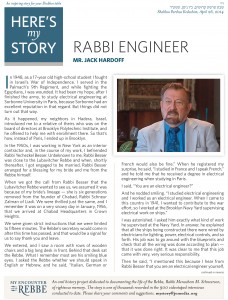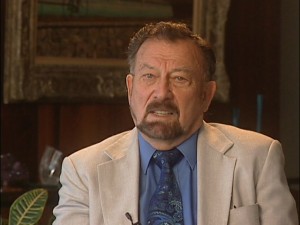Rabbi Engineer
In 1948, as a 17-year old high-school student I fought in Israel’s War of Independence. I served in the Palmach’s 9th Regiment, and while fighting the Egyptians, I was wounded. It had been my hope, after I finished the army, to study electrical engineering at Sorbonne University in Paris, because Sorbonne had an excellent reputation in that regard. But things did not turn out that way.
As it happened, my neighbors in Hadera, Israel, introduced me to a relative of theirs who was on the board of directors at Brooklyn Polytechnic Institute, and he offered to help me with enrollment there. So that’s how, instead of Paris, I ended up in Brooklyn.
In the 1950s, I was working in New York as an interior contractor and, in the course of my work, I befriended Rabbi Yechezkel Besser. Unbeknown to me, Rabbi Besser was close to the Lubavitcher Rebbe and when, shortly thereafter, I got engaged to be married, Rabbi Besser arranged for a blessing for my bride and me from the Rebbe himself.
When we got the call from Rabbi Besser that the Lubavitcher Rebbe wanted to see us, we assumed it was because of my bride’s lineage – she is six generations removed from the founder of Chabad, Rabbi Schneur Zalman of Liadi. We were thrilled just the same, and I remember it was on a very snowy day in January, 1956, that we arrived at Chabad Headquarters in Crown Heights.
We were given strict instructions that we were limited to fifteen minutes. The Rebbe’s secretary would come in after this time has passed, and that would be a signal for us to say thank you and leave.
We entered, and I saw a room with rows of wooden chairs and a big long desk in front. Behind that desk sat the Rebbe. What I remember most are his smiling blue eyes. I asked the Rebbe whether we should speak in English or Hebrew, and he said, “Italian, German or French would also be fine.” When he registered my surprise, he said, “I studied in France and I speak French,” and he told me that he received a degree in electrical engineering when studying in Paris.
I said, “You are an electrical engineer?”
And he nodded smiling. “I studied electrical engineering and I worked as an electrical engineer. When I came to this country in 1941, I wanted to contribute to the war effort, so I worked at the Brooklyn Navy Yard supervising electrical work on ships.”
I was astonished. I asked him exactly what kind of work he supervised at the Navy Yard. In answer, he explained that all the ships being constructed there were wired by electricians for lighting, power, electrical controls, and so forth. His job was to go around with the blueprints and check that all the wiring was done according to plan – that it was done right. It was clear to me that this job came with very, very serious responsibility.
Then he said, “I mentioned this because I hear from Rabbi Besser that you are an electrical engineer yourself, and a very knowledgeable one at that. If you don’t mind, I’d like to ask you some questions.”
And that’s how our discussion turned to the newest advances in electronics.
He said, “I want you to explain some things to me. I hear that there is something new coming in called ‘a solid state transistor.’ Can you tell me what it’s all about – how does it work?” He was really eager to know the details.
What was to be a fifteen-minute meeting lasted close to two hours. He pulled out a yellow pad, I came over to his desk, and we started drawing diagrams.
We compared the size of a little transistor, which is a quarter-inch by a quarter-inch, to a vacuum tube, which is four inches high and over an inch wide. We compared the fact that transistors use very low voltages – five volts, six volts, at maximum twelve – to the audio amplifiers of the day which were using 450 volts. And we talked about the transformers that were weighing two pounds apiece.
The Rebbe thought about it for a moment, and then he said, “In that case, tell me, am I right that this will revolutionize the whole field of electronics? Electronic devices that are now so very heavy are going to weigh a small fraction of that…”
I was amazed at the insight he had into the future, into possibilities, into potentials.
He also asked me about using electric rheostats. Rheostats are rotary devices that control the speed of motors. He had a lot to do with them at the Navy Yard. “Will solid state allow for devices that are not as big, clumsy and heavy as the rheostats, the variable speed controllers?”
I told him that, as far as I knew, they were already working on developing solid state speed controls. And he wanted the details on that. He was eager to know as much as possible about the developments in solid state versus vacuum tubes, in controls, motors and amplifications.
I couldn’t believe he knew about all these things, and I was astonished at his vision for their application in the future.
When we finished and he gave us the blessing for many years of happiness of married life, he said to me, “You know Yaakov ben Eliezer, when people come here to see me, I am the rabbi and they’re the pupils, but today you were the rabbi and I was the pupil.”
I’ll never forget this compliment he gave me. It is something I will remember for all my life.
These days, when I meet Lubavitchers, I am reminded of the Rebbe – I remember his personality, his attitude, his humor and his unbelievable curiosity about all things, not just religious things, in this world. I was very impressed by that, and I got a new respect for religious people because of him. I am grateful to him for that.
The late Mr. Jack Hardoff lived in Miami, Florida with his wife, Nina. He was interviewed in Miami in May, 2006.








No Comments to “Rabbi Engineer”